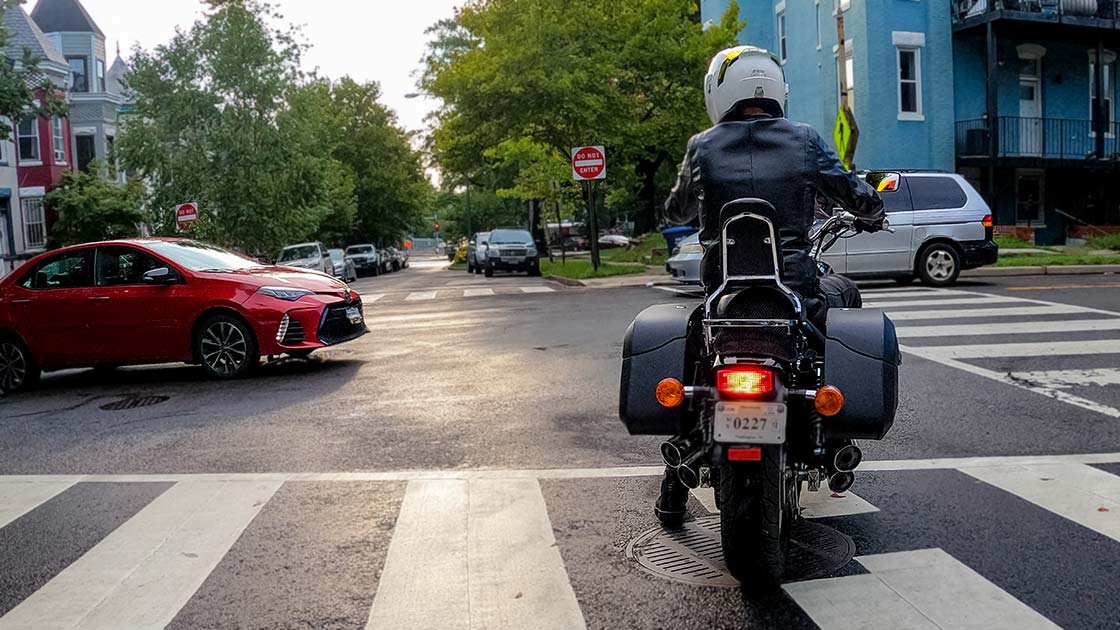Insight
Simple steps could reduce motorcyclist deaths — if only we’d take them
August 24, 2023

In the 15 years since I began researching motorcyclist safety, evidence has continued piling up about commonsense measures that could reduce deaths. However, we have failed to fully implement these solutions, and the death toll in the U.S. has continued to rise, reaching a record high of over 6,000 in 2021, the latest year for which statistics are available. Thinking of all the motorcyclists I’ve known in the safety community over the years, this toll isn’t just a number to me. We’ve got to do more to address this aspect of our road safety crisis.
Motorcyclists are often labeled as risk-takers, so perhaps that’s why our society continues to accept this loss of life. It’s true that riding involves extra risk compared with driving passenger vehicles, but it’s possible to reduce the risk without diminishing the joys and thrills that define motorcycling. If we’re serious about reducing motorcyclist deaths, we need, at a minimum, universal helmet laws in all states, antilock braking systems (ABS) on all new bikes, crash avoidance systems that detect motorcyclists, and a plan for lowering speeds of all vehicles on the road.
Together, these ideas make up a Safe System approach to reducing motorcyclist deaths and injuries. The Safe System idea — which has been incorporated into the federal government’s highway safety strategy, as well as that of many cities and states — recognizes that humans make mistakes, that mistakes should not lead to death and that everyone has a role to play.
Mandatory helmet use is perhaps the most obvious item on my wish list, yet fewer than half of states require helmet use by all riders. Properly designed helmets reduce the likelihood of death by about 40 percent and the risk of traumatic brain injury by two-thirds. Over the years, when states weakened their helmet use laws, motorcyclist death rates almost always increased; when states strengthened their laws, death rates almost always declined. Helmet requirements are unpopular among some people, but they save lives.
In addition to protecting riders in crashes, it’s also crucial to reduce the risk of crashing in the first place. Studies have shown that motorcycle ABS reduces crash rates. Crashes not outright prevented by ABS often are less severe as it helps riders brake harder and avoid serious falls while doing so.
The proliferation of motorcycle ABS over the past two decades is a bright spot in the otherwise grim safety picture. We’ve gone from having almost no motorcycles with standard ABS in 2003 to about two-thirds of 2023 models with standard ABS.
This rise can be attributed to both increased demand among U.S. consumers and to production practices driven by the many governments around the world that have mandated ABS, including all European Union member states, the United Kingdom, Brazil, Japan, Taiwan, Australia, New Zealand and India. Our own government should follow the example set by these countries and require this lifesaving technology on new on-road motorcycles. Such a requirement would close the gap that still leaves a third of motorcycle models sold in the U.S. without standard ABS. IIHS-HLDI petitioned the National Highway Traffic Safety Administration to do this back in 2013, but there has been no response or action taken.
Improving safety for motorcyclists extends beyond the handlebars. Preventing other vehicles from colliding with motorcycles is also key. We know from studies that failure to see motorcyclists or properly judge their speed is a common factor in crashes. One of the ways to address this is to make sure crash avoidance systems are designed to detect motorcyclists.
Automatic emergency braking (AEB) is almost ubiquitous on new passenger vehicles, in large part thanks to a voluntary commitment by automakers to make the technology standard. A planned regulation from the federal government would make AEB mandatory and increase its performance requirements, but the proposal does not require motorcyclist detection, nor does another proposed rule requiring AEB on heavy vehicles.
IIHS is attempting to fill this gap to the extent possible. We are currently updating the passenger vehicle AEB testing that we have been conducting since 2013. While our original test looked at whether these systems prevented rear-end crashes with other passenger vehicles, our new test adds detection of large trucks and motorcyclists. The first ratings in the new evaluation will be released later this year.
A related emerging technology, left turn assist, has the potential to address crashes in which another vehicle turns left in front of an oncoming motorcycle — the most common type of crash between a motorcycle and another vehicle. Left turn assist uses a camera and other sensors to detect oncoming vehicles when the driver signals a left turn, warning against proceeding or automatically braking if the software determines a collision is likely. As this and other new technologies are developed and proliferate, it’s essential that motorcyclist detection be incorporated into their design.
Finally, we must remember that all countermeasures work better at lower speeds. That goes not only for motorcyclists, but for all road users. Lower speeds increase the time available to avoid a crash and reduce the forces when crashes do happen.
Unfortunately, states have been raising speed limits since the late 1980s, with some now as high as 80 and, in one case, 85. These increases have very real consequences and are inconsistent with states’ goals of reducing or eliminating crash deaths. On the other hand, several cities have lowered their speed limits and observed safety benefits as a result. If we want fewer deaths — of motorcyclists or any other road users — then speed limits need to come down, and speeding must be taken more seriously.
Policy decisions and technological advances like the ones outlined above are crucial for reducing motorcyclist fatalities, but riders themselves also have a major role to play. As they enjoy the thrills of the road, I encourage riders to avoid underestimating what could go wrong. Even the best motorcyclist can’t control the actions of other road users, so it’s essential that riders avoid speeding and alcohol impairment and protect themselves. Even where not required, riders should wear a properly designed helmet as well as other protective clothing. And they should make sure the motorcycle they purchase, whether new or used, has ABS. (Our online tool makes it easy to check.)
Each one of the thousands of motorcyclists who die on U.S. roads every year is someone’s loved one. It’s time to end our complacency and implement commonsense changes — stronger helmet laws, universal ABS, more robust crash avoidance and lower speeds — as foundational pieces of a Safe System. Even as we continue to research further ways to improve rider safety, we can take these lifesaving steps now.
